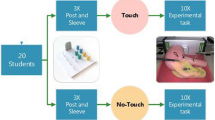Abstract
The designing of a laparoscopic simulator, particularly the parameterizing of a force feedback system, has drawn attention to the question of characterizing laparoscopic gestures and effecting quantitative measurement of the various interactions between the organs and the instruments used to operate in the case of animals. These measurements use an instrument previously developed by the authors’ team. Laparoscopic gestures are characterized by a visual component and a haptic component. The visual component cannot, of course, be disregarded. The amplitude of the forces generated by interaction between organ and instrument in relation to that of the forces linked with other mechanical phenomena interfering with somesthesic information, such as friction of the operative instrument in the trocar or resistance of the abdominal wall to tilting movement, has led to a discussion about the extent of haptic components involved in the performance of laparoscopic gestures. After describing the measurement’s device and the different forces applied on the surgical instrument, the authors describe the measurement of the rubbing strengths caused by the slippage of the instrument in the trocar and one of the elastic torques induced by the abdominal wall when the trocar in slanted. Comparison of values with those obtained during interactions with various organs shows that during some delicate surgical gestures, the influence of the instrument can disturb the haptic sensation. Interference of haptic sensation is greatest at maximal tilting angles and at maximal velocity of insertion and removal movement.






Similar content being viewed by others
References
I Brouwer J Ustin L Bentley A Sherman N Dhruv F Tendick (2001) ArticleTitleMeasuring in vivo animal soft tissue properties for haptic modeling in surgical simulation Stud Health Technol Inform 81 69–74
FJ Carter TG Frank PJ Davies D McLean A Cuschieri (2001) ArticleTitleMeasurements and modelling of the compliance of human and porcine organs Med Image Anal 5 231–236
A Chaudhry C Sutton J Wood R Stone R McCloy (1999) ArticleTitleLearning rate for laparoscopic surgical skills on MIST VR, a virtual reality simulator: quality of human–computer interface Ann R Coll Surg Engl 81 281–286
KT Boer Particleden JL Herder W Sjoerdsma DW Meijer DJ Gouma HG Stassen (1999) ArticleTitleSensitivity of laparoscopic dissectors: what can you feel? Surg Endosc 13 869–873 Occurrence Handle10.1007/s004649901122 Occurrence Handle10449841
Dubois P, Delemar G, Picod G (2002a) Measurements of mechanical interactions between a surgical instrument and an organ: methodological aspects of the IASTED. International Conference on Applied Simulation and Modelling, Crete, Greece pp 174–179
P Dubois Q Thommen AC Jambon (2002b) ArticleTitleIn vivo measurement of surgical gestures IEEE Trans Biomed Eng 49 49–54
AC Jambon F Dubecq-Princeteau P Dubois S Karpf C Chaillou P Meseure D Querleu (1998) ArticleTitleSPIC: a training simulator for coelioscopic interventions with gynecologic purpose J Gynecol Obstet Biol Reprod (Paris) 27 536–543
AC Jambon D Querleu P Dubois C Chaillou P Meseure S Karpf C Geron (2000) ArticleTitleSPIC pedagogical simulator for gynecologic laparoscopy Stud Health Technol Inform 70 139–145
J Marescaux MK Smith D Folscher F Jamali B Malassagne J Leroy (2001) ArticleTitleTelerobotic laparoscopic cholecystectomy: initial clinical experience with 25 patients Ann Surg 234 1–7 Occurrence Handle10.1097/00000658-200107000-00001 Occurrence Handle1:STN:280:DC%2BD3MzlvFCisg%3D%3D Occurrence Handle11420476
MP Ottensmeyer E Ben-Ur JK Salisbury (2000) ArticleTitleInput and output for surgical simulation: devices to measure tissue properties in vivo and a haptic interface for laparoscopy simulators Stud Health Technol Inform 70 236–242
G Picod AC Jambon P Dubois D Vinatier (2003) ArticleTitleMeasurements of the friction in the sheath of trocars used in laparoscopy ITBM-RBM, 24 217–222
J Rosen B Hannaford CG Richards MN Sinanan (2001) ArticleTitleMarkov modeling of minimally invasive surgery based on tool/tissue interaction and force/torque signatures for evaluating surgical skills IEEE Trans Biomed Eng 48 579–591
J Rosen M MacFarlane C Richards B Hannaford M Sinanan (1999) ArticleTitleSurgeon-tool force/torque signatures: evaluation of surgical skills in minimally invasive surgery Stud Health Technol Inform 62 290–296
L Toledo D Gossot S Fritsch Y Revillon C Reboulet (1999) ArticleTitleStudy of sustained forces and the working space of endoscopic surgery instruments Ann Chir 53 587–597
MS Wilson A Middlebrook C Sutton R Stone RF McCloy (1997) ArticleTitleMIST VR: a virtual reality trainer for laparoscopic surgery assesses performance Ann R Coll Surg Engl 79 403–440
Author information
Authors and Affiliations
Corresponding author
Rights and permissions
About this article
Cite this article
Picod, G., Jambon, A.C., Vinatier, D. et al. What can the operator actually feel when performing a laparoscopy?. Surg Endosc 19, 95–100 (2005). https://doi.org/10.1007/s00464-003-9330-3
Received:
Accepted:
Published:
Issue Date:
DOI: https://doi.org/10.1007/s00464-003-9330-3




